 Slide 1
This presentation is the result of over 12 years experience with planted aquariums.
Much of the material discussed here has been published and archived in various locations
on the Internet, such as
Slide 1
This presentation is the result of over 12 years experience with planted aquariums.
Much of the material discussed here has been published and archived in various locations
on the Internet, such ashttp://www.frii.com/~booth/AquaticConcepts/
http://www.thekrib.com
and has been published in various issues of Aquarium Fish Magazine. This slide is the lead photo for a four part series in AFM beginning in November, 1992.
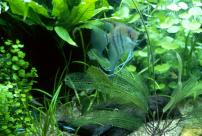 Slide 2
Why do we do planted aquariums? It's definitely not because they are easier to maintain
than fish-only setups. In truth they are at least as difficult as reef tanks; maybe more so
because there still isn't a large infrastructure of commercial solutions in place. We do it
because we think a well-setup plant tank is aesthetically unsurpassed by any other type of
aquarium. We also feel that a planted tank is the ideal environment for the specimen fish we
keep.
Slide 2
Why do we do planted aquariums? It's definitely not because they are easier to maintain
than fish-only setups. In truth they are at least as difficult as reef tanks; maybe more so
because there still isn't a large infrastructure of commercial solutions in place. We do it
because we think a well-setup plant tank is aesthetically unsurpassed by any other type of
aquarium. We also feel that a planted tank is the ideal environment for the specimen fish we
keep.
This photo of an angelfish in a nicely aquascaped surrounding should give testimony to that. We enjoy both the plants and the fish and tend to keep heavier fish loads than people interested solely in aquatic gardening. We think of our setups as "planted display aquariums" rather than "aquatic gardens". Higher fish loads require more maintenance, but that's our choice.
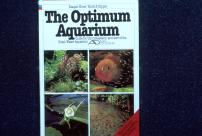 Slide 3
We created our first planted tanks in 1986. Although there were a few plant fertilizer
products on the market, there was very little organized information. Various plant books
were available but most simply described plants as "easy" or "difficult" and didnít go
into why they were that way. Easy plants would grow for anyone, at least for a while.
Difficult plants required some kind of aquatic green thumb or magic water and none of
the books described how to get either of those.
Slide 3
We created our first planted tanks in 1986. Although there were a few plant fertilizer
products on the market, there was very little organized information. Various plant books
were available but most simply described plants as "easy" or "difficult" and didnít go
into why they were that way. Easy plants would grow for anyone, at least for a while.
Difficult plants required some kind of aquatic green thumb or magic water and none of
the books described how to get either of those.
While browsing a pet shop one day, we came across this book, The Optimum Aquarium by Horst and Kipper, the owners of the famous German firm, Dupla. Even a casual glance through the book showed us how different it was from other books. It described a method, backed up by research and products, that would allow anyone to grow an aquatic green thumb and create magic water! One of the revelations in the book was the use of carbon dioxide (CO2) as a fertilizer.
All of our techniques are based on the contents of the book. Unfortunately, it is currently out of print, but there are many other excellent resources that can provide the same level of information. The handout has further information.
 Slide 4
Dupla has a set of "10 Golden Rules" that will enable the aquarist to produce a beautiful
and stable planted aquarium. Some authors may disagree with the number of rules or the
grouping of ideas in the various categories, but all 10 rules are valid and are based on
the requirements of both plants and fish in a planted aquarium. We will cover most of the
10 Rules in some form or another as the presentation proceeds.
Slide 4
Dupla has a set of "10 Golden Rules" that will enable the aquarist to produce a beautiful
and stable planted aquarium. Some authors may disagree with the number of rules or the
grouping of ideas in the various categories, but all 10 rules are valid and are based on
the requirements of both plants and fish in a planted aquarium. We will cover most of the
10 Rules in some form or another as the presentation proceeds.
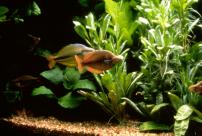 Slide 5
What do we mean by our title "Modern Aquascaping"? Surely, aquascaping has been around for
quite awhile. What is modern about it? We like to think that we are using more modern or
high-tech methods and equipment to allow lush plant growth and higher fish loads
than more traditional techniques. While many aquatic gardeners tend to use small fish like
tetras in their setups, we enjoy displaying bigger fish like the Rainbowfish shown here.
Fish like this are ideal in a planted tank and plants make an ideal environment for them.
Only some of the larger fish species are suitable for planted tanks but for those that are,
the plants truly enhance the health and color of the fish.
Slide 5
What do we mean by our title "Modern Aquascaping"? Surely, aquascaping has been around for
quite awhile. What is modern about it? We like to think that we are using more modern or
high-tech methods and equipment to allow lush plant growth and higher fish loads
than more traditional techniques. While many aquatic gardeners tend to use small fish like
tetras in their setups, we enjoy displaying bigger fish like the Rainbowfish shown here.
Fish like this are ideal in a planted tank and plants make an ideal environment for them.
Only some of the larger fish species are suitable for planted tanks but for those that are,
the plants truly enhance the health and color of the fish.
The term aquascaping refers to the overall arrangement of the plants for color, texture, size and shape. The next few slides will illustrate some of those ideas.
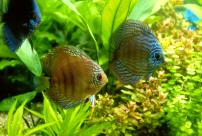 Slide 6
Note here that various colors and textures are used to keep things interesting. Long, thin
sword plants, leafy orange-colored plants and a different textured green plant keep the
eye busy.
Slide 6
Note here that various colors and textures are used to keep things interesting. Long, thin
sword plants, leafy orange-colored plants and a different textured green plant keep the
eye busy.
Discus are traditionally kept in sterile tanks where they can be well fed and easily bred. But as seen here, a nicely aquascaped setting makes a stunning background for discus. The plants also help provide a healthy environment by acting as natural filters for the water and by providing higher levels of oxygen. This is especially important for us, since we live at a higher altitude (5000 ft) with about 20% less oxygen in the air than at sea level.
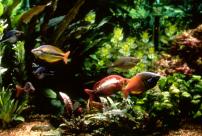 Slide 7
Various textures and colors are again used to good effect. Note how your eye tends to start
at the lower left with the bare gravel, then is led to the right, up and around by the
various colors and heights of plants.
Slide 7
Various textures and colors are again used to good effect. Note how your eye tends to start
at the lower left with the bare gravel, then is led to the right, up and around by the
various colors and heights of plants.
This is another shot of Rainbowfish. With the range of colors of the various species, many people, even some experienced aquarists, think we have saltwater tanks when they first see them. If you think you need to have a reef tank to get a colorful display, think again!
 Slide 8
Here, a strong central splash of bright green is offset by smaller plants with different
colors and textures. You tend to focus on the middle plant but your eyes keep getting
pulled in different directions. This is an old artist's trick to make a painting interesting.
It also works well here, too.
Slide 8
Here, a strong central splash of bright green is offset by smaller plants with different
colors and textures. You tend to focus on the middle plant but your eyes keep getting
pulled in different directions. This is an old artist's trick to make a painting interesting.
It also works well here, too.
This is another nice setting for a couple of happy discus. Even though the water temperature is 83 F in this tank, most plants will still thrive. Some plants may require a period of adaptation before they grow well, but we have found very few plants that don't like higher temperatures.
 Slide 9
This shot of another discus shows a rather cluttered scene. There are certainly many colors
and textures, but the overall impression is chaotic. There are no strong central areas or
leading lines to guide the eye. In this case, there are too many elements.
Slide 9
This shot of another discus shows a rather cluttered scene. There are certainly many colors
and textures, but the overall impression is chaotic. There are no strong central areas or
leading lines to guide the eye. In this case, there are too many elements.
 Slide 10
Another cluttered scene but the fish donít seem to mind! Here, a female Boseman's Rainbowfish
is tucked in the plants to the left and males of four different types are in a spawning
frenzy. This is fascinating to watch and shows how much the fish appreciate the plants.
Slide 10
Another cluttered scene but the fish donít seem to mind! Here, a female Boseman's Rainbowfish
is tucked in the plants to the left and males of four different types are in a spawning
frenzy. This is fascinating to watch and shows how much the fish appreciate the plants.
 Slide 11
These two discus have spawned on the broad Anubias leave in the middle. You can see
the fry being herded by the parent below the leaf. This should testify that discus and plants
go well together.
Slide 11
These two discus have spawned on the broad Anubias leave in the middle. You can see
the fry being herded by the parent below the leaf. This should testify that discus and plants
go well together.